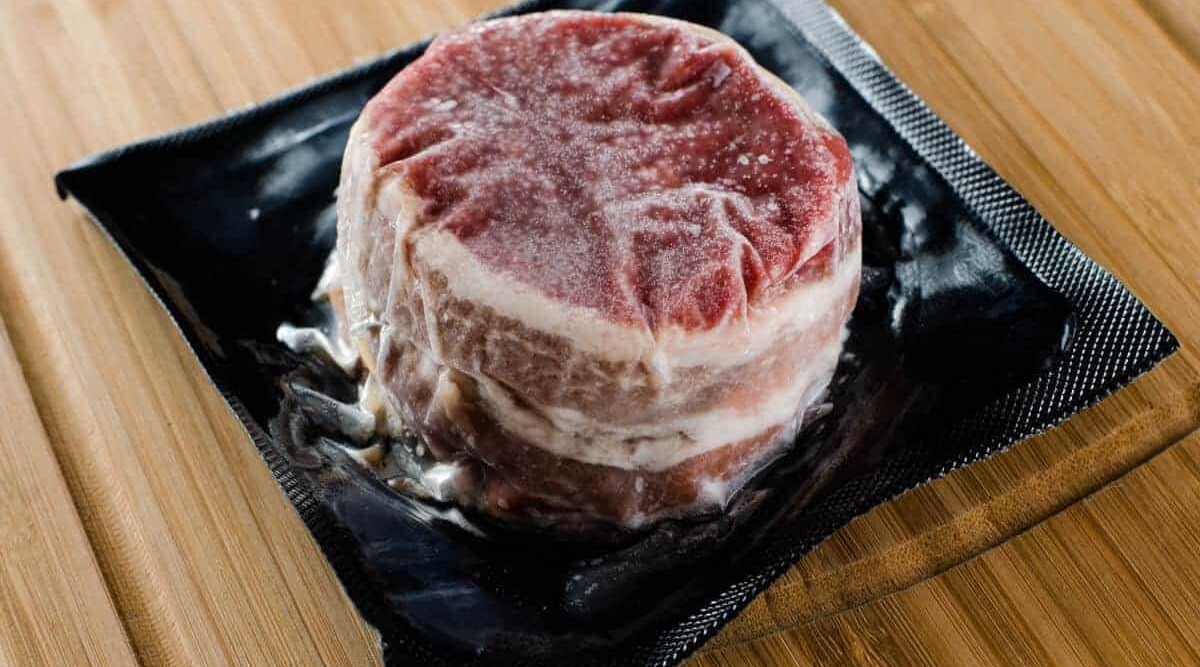
Maybe you’ve heard rumors of steak going from freezer, to grill, to plate within 30 minutes but didn’t quite believe anything good could come of it?
Well, you’re wrong. Plenty of people are grilling frozen steak and enjoying fantastic results!
In this article, we look at how to grill a frozen steak with a step-by-step instruction list, before diving into the science and the pros and cons of it.
The big bonus? Snapping up all those bargain steaks close to sell by date that regularly go on sale, storing them in your freezer and short-cutting the time required to get them onto your plate!
Jump to:
The Pros of Grilling Frozen Steak
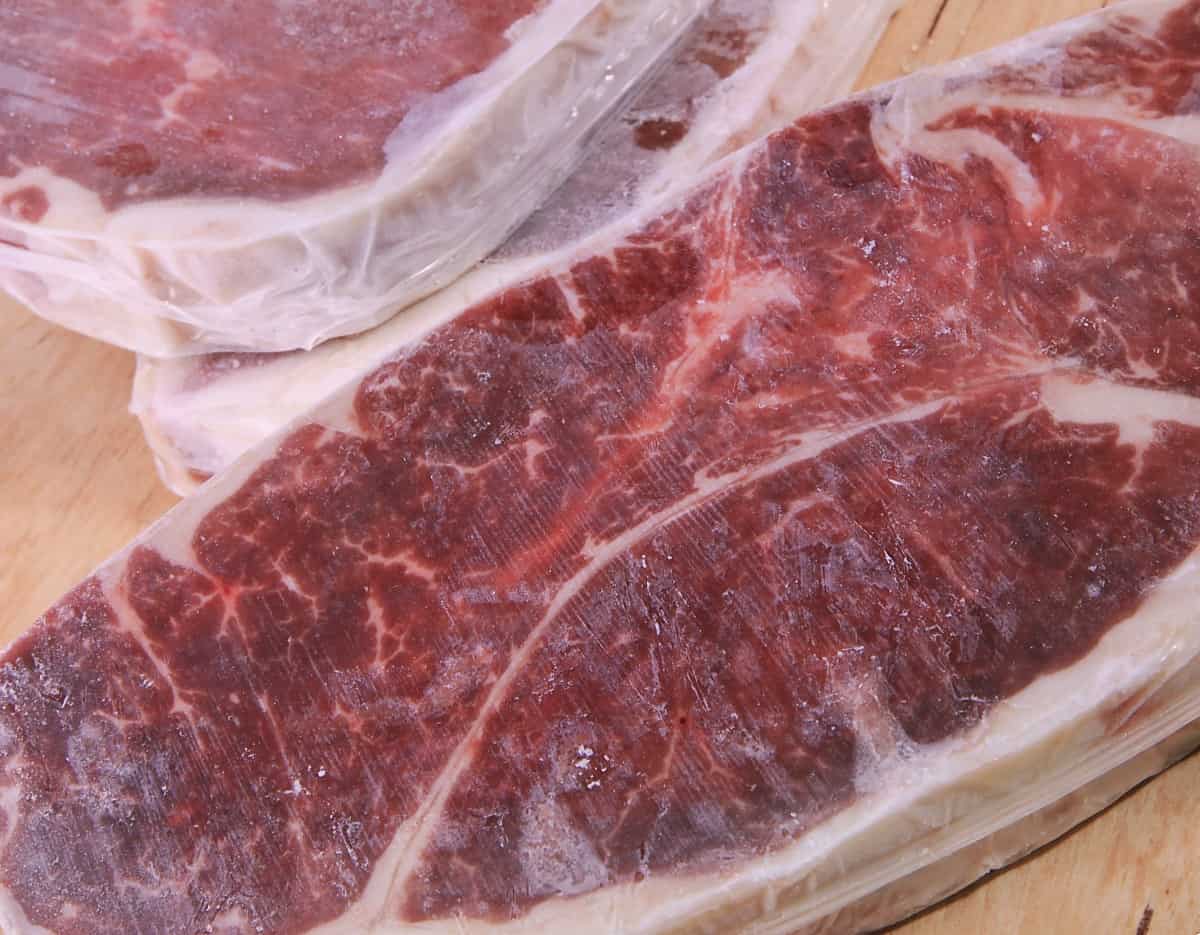
Thermal protection for the inside the meat is how Kim at ThermoWorks describes the way the frozen surface keeps the inside the steak from overcooking.
Basically, the frozen outer layer absorbs much of the high heat of the grill, allowing the steak to cook through as it should — more heat on the outside, less on the inside.
Avoid the gray band often seen on thawed meat. Usually an inch or so deep, this is the result of the protein fibers contracting, forcing water out of the meat — and all hopes of tender steak with it.
Lower loss of moisture. Because a lot of the moisture during the early stages of cooking is held as solid ice, less escapes across the whole cook.
More flavor. It’s far easier to develop a really deep, all over flavorful Maillard crust when you have less chance and fear of overcooking the center.
No wait time for thawing! Yes, the actual cooking time is longer compared to cooking a thawed steak, but overall-time from freezer to fork is a fraction of the usual time of defrosting a steak before cooking.
And, if you’re wondering if it’s safe, the U.S. Department of Agriculture says:
“It is safe to cook foods from the frozen state. The cooking will take approximately 50% longer than the recommended time for fully thawed or fresh meat and poultry.”
Downsides to Grilling Steak from Frozen
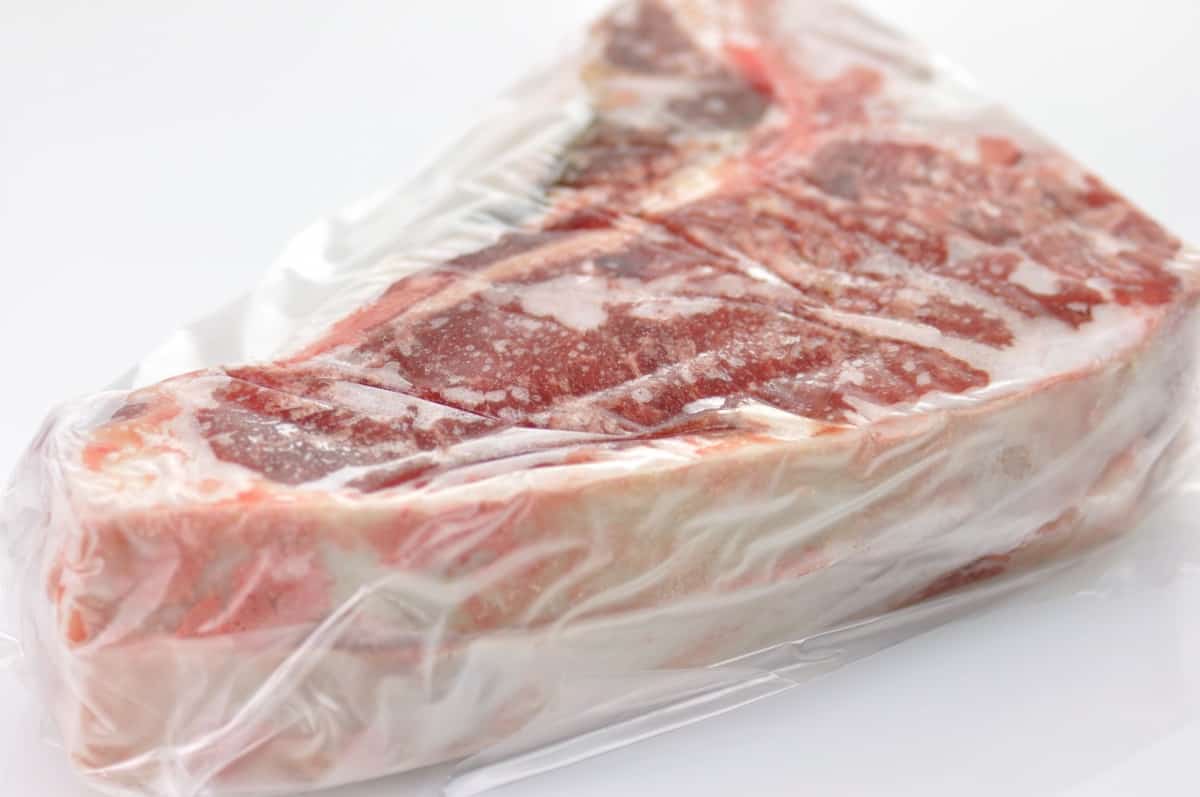
Takes about twice as long compared to a fresh steak. — You will need more time in the heat to reach your preferred doneness level as the meat is starting from a lower temperature.
If freezing your own, the process could be space — and time-consuming. — You don’t merely throw the steak in the freezer, as you will see later, you need almost an entire rack in your freezer.
The danger of flare-up on the grill from ice melt if it isn’t thoroughly dry. — As the steak defrosts, water can drip off onto the coals, taking fats with it that will burn on the coals.
You cannot cook a steak blue from frozen. — If cooking steak blue is your thing, then you need to start with a fully defrosted, and very dry steak, otherwise you will never get a good sear while keeping the inside blue. It’s just not going to ever happen.
How to Grill Frozen Steak, Step-by-Step
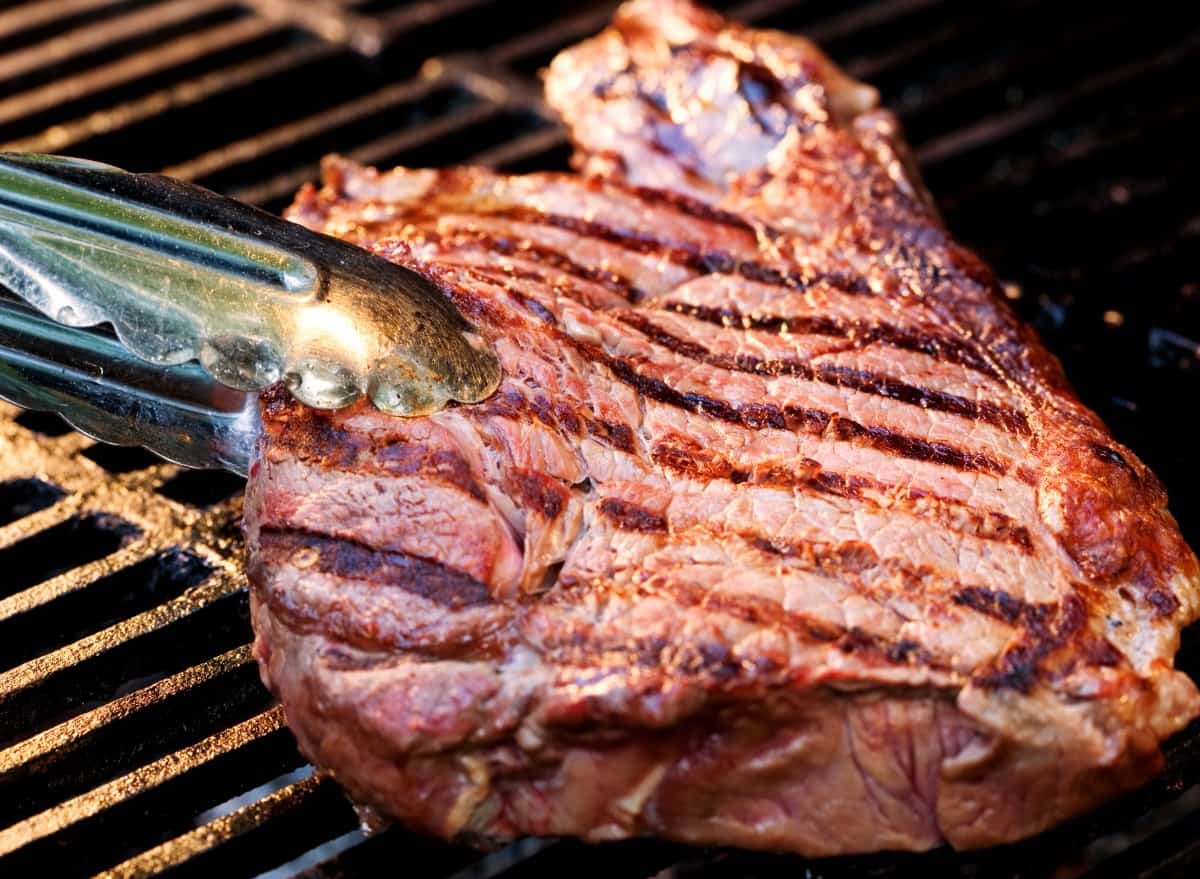
Step 1: Purchase fresh or frozen cuts of steak of at least 1½” thickness.
Step 2: If fresh, lay it on a parchment paper-covered cookie sheet and place, uncovered, in the freezer for 5 hours or until thoroughly frozen. Remove from pan and securely seal in a plastic bag for later use.
Step 3: If frozen, ensure the steak surface is flat top and bottom. Dips and lumps will cause uneven cooking. Be sure once frozen it is free of freezer burn or ice.
Step 4: Set up the grill for 2-zone cooking:
- Gas grill: TW recommends turning on all burners until the grill is hot, then turning off all burners except the primary burner.
- Charcoal grill: Place charcoal into a chimney starter and light. Arrange charcoal on one side of the grill. Empty chimney starter onto coals, then allow to heat. Adjust dampers as necessary.
Step 5: Heat the grill — 5 minutes for a gas grill, 15 minutes for a charcoal grill
Step 6: When charcoal/burner reaches a minimum of 500 °F, place dry steak(s) on a clean grill grate.
Step 7: Cook to 70 °F internal temp (5–7 minutes per side).
Step 8: Season with kosher salt and pepper, if desired, and turn the steak.
Step 9: When the internal temperature reaches 115 °F, move it to the indirect heat zone.
Step 10: Depending on the desired doneness, remove the steak when it reaches:
- 110 °F for rare
- 115 °F for medium rare
- 125 °F for medium
- 135 °F for medium well
- 145 °F for well done
NOTE: These values are lower than the doneness temperatures we provide just a few paragraphs above. This is in anticipation of ‘carry over’ cooking, where once you remove the steak, the outside layer is far hotter than the center, and as the temperature equalizes, the interior temperature raises a further 5 degrees or so.
Step 11: As per our guide on how long to rest steak, let it rest for 5 minutes or until carry-over cooking brings the temperature up to the range noted above in the doneness section.
Step 12: Enjoy!
Tips and Key Considerations for How It’s Done
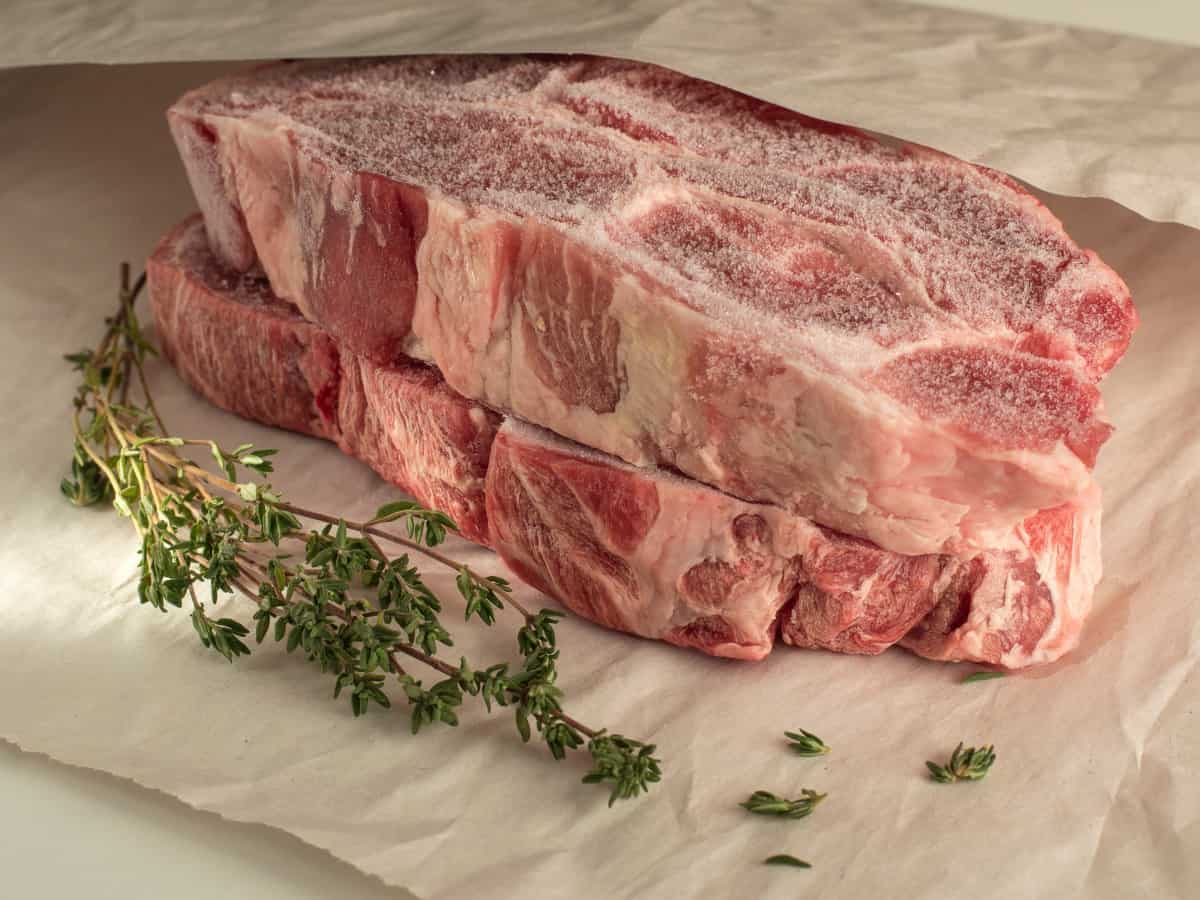
Cook’s Illustrated chef Andrea Geary, after testing various thicknesses, cuts, and temperatures, set out a few keys for perfectly grilling frozen steak:
Key 1: Thickness of the Meat
She started with flank and skirt steaks. The longer cook time was too much for these thin cuts; they burned up.
The chef next tried ribeye and strips of 1 ½” thickness and was rewarded with tender, perfectly grilled cuts. So these are the best steak cuts for grilling from frozen.
Thick-cut frozen pork chops turned out well, too.
Key 2: Grill Set-up
The 2-zone set up was found to be the optimal cooking arrangement. Direct heat first to create a crust, followed by indirect heat to gently and evenly finish cooking.
For a gas grill, if you haven’t already figured it out, you’ll have to determine the optimal distance from the burner for food to continue cooking at a lower temperature.
For the newer generation models with vertically placed burners, a distance of 6 inches was just right.
The ideal temperature range on older models with horizontally placed burners was 10 inches or less. Use an IR thermometer to find your grill’s optimal indirect heat zone.
Key 3: Temperature Control
Taking a steak from solid cold to tender and hot requires close monitoring of temperatures. You’ll need to work with thermometers inside and out:
Outside — Grill Temps
The grill temperature should be 500 to 700 °F for the direct heat side and 225 °F to 350 °F for the indirect side.
Inside — Your Steak, That is
In the first stage, cook the steak until it reaches 70–90 °F internal. In time, this is 5 to 7 minutes per side.
In the second stage, take the steak off the grill when it reaches 115 °F for rare (or, as per ThermoWorks, 125 °F for medium rare). This is about 12 minutes of cooking time per side.
You could go by the clock, but if you’re serious about the difference between medium-rare and rare, you’ll need a probe thermometer.
What Are the Doneness Temperatures?
We have an entire article dedicated to the time it takes to grill different steaks, as well as a steak doneness guide with chart. But in summary, these are temperatures we’re aiming for:
- Rare — 115 to 120 °F
- Medium Rare — 120 to 125 °F
- Medium — 130 to 135 °F
- Medium Well — 140 to 145 °F
- Well Done — 150 °F+
Key 4: Flavor Source
Nothing sticks to a dry, frozen steak so if you’re fond of coating your meat with a marinade or rub before it hits the grill, here’s an opportunity to try something different.
Choose meat that has sufficient flavor on its own. You can find many discussions on flavor profiles based on cut, grade, feed, and fat content. But the more you grill, the more opportunity to determine what works best for your taste buds.
Apparently, no one has tried freezing a marinated steak, yet. Or maybe someone has but hasn’t cared to comment on it. Have you?
Finally, if you start out with quality meat, the seasoning will only be a compliment, not a compensation.
Now that you have the keys, and the why’s, let’s go on to the best part.
How to Freeze a Steak Flat — Critical for Success
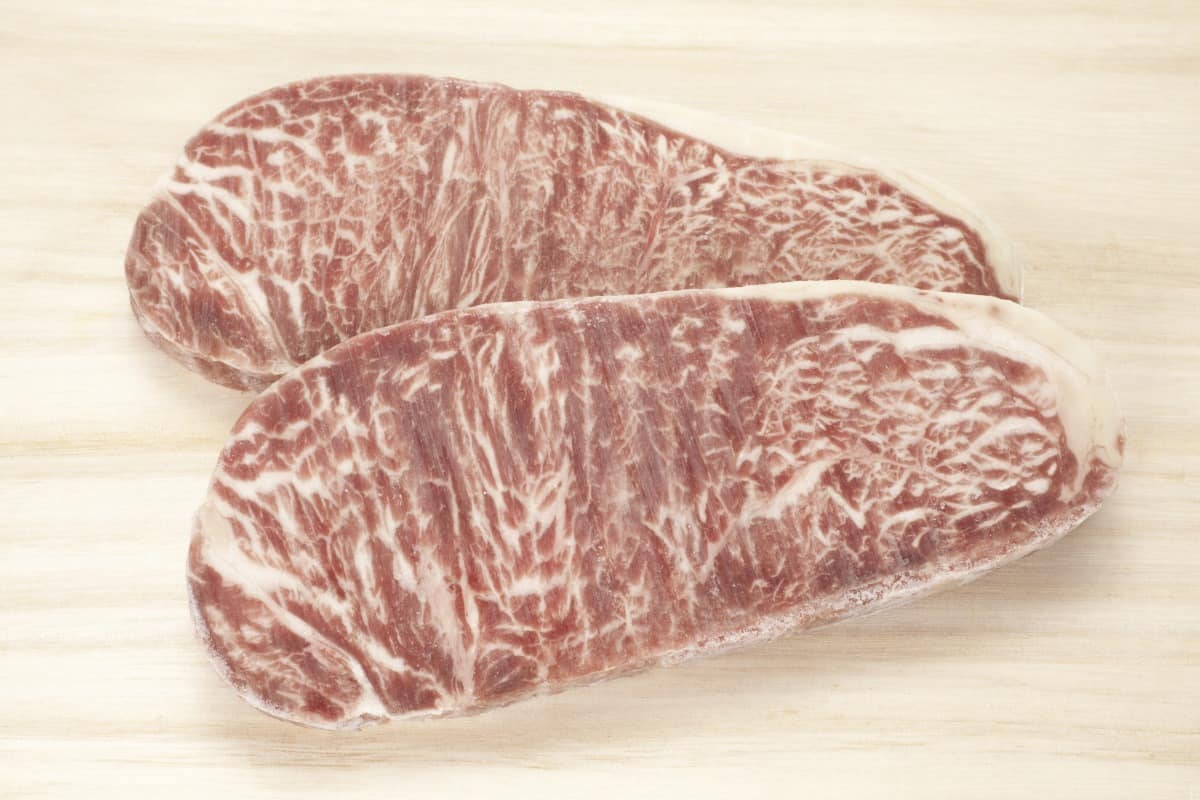
To successfully grill frozen steaks, the surface of it should be as smooth and flat as possible. The entire surface of the steak should touch the cooking surface all at the same time. In this way, the heat will be evenly distributed across the surface, so it cooks through evenly.
This works if you have or can make the freezer space, especially for the first part of this 2-part process. Kim at ThermoWorks recommends:
- Remove steak from packaging.
- Pat dry.
- Cover a cookie sheet or shallow baking pan with parchment paper.
- Place the steak(s) on the paper. The flat surface will ensure if they freeze smooth and flat.
- Place the cookie sheet into the freezer. Do not cover the steak. Leaving the meat directly exposed to the air of the freezer will evaporate surface moisture. This will result in a better sear when it goes on the grill.
- Once the steak is thoroughly frozen (generally about 5 hours), remove from the cookie sheet.
- Store dry, frozen steak(s) in a well-sealed plastic bag. Freezer paper may also work well. Whichever method you use, be sure the meat is completely sealed away from the air of the freezer to prevent freezer burn and frost or icing. For optimal flavor, keep frozen no more than six months.
Now you’ve got steaks ready to go from freezer to plate in less than 30 minutes.
And you can now take advantage of a good steak sale nearing use by dates, and fearlessly stock the freezer with a supply of quick meals!
Just make sure you’re wise on how to know if steak is bad before buying near use by date steaks, as sometimes they can be very close to or even past gone off.
Conclusion
You can cook a steak from frozen, and the results can be tremendous. Who’d have thought it, eh?
Tell us, have you ever cooked straight from frozen? How were your results? Is it something you’re likely to do again? Do you have any tips for cooking frozen steak that we haven’t covered here and that might help others?
We’d love to hear about your experiences and tips in the comments below.


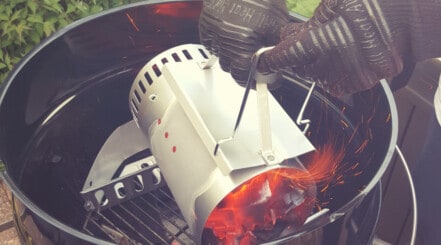
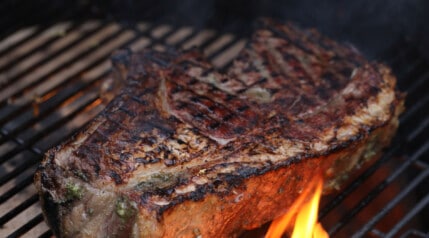
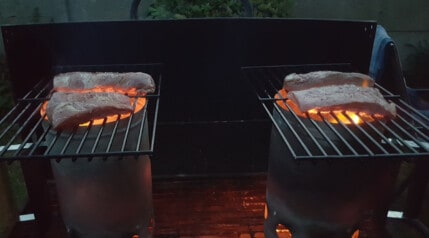
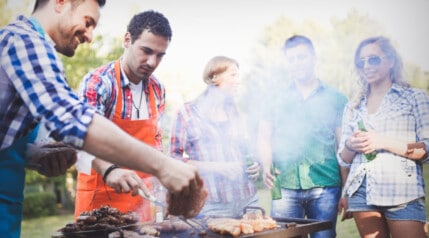
Thanks for the article. I have 2 questions. First, do you do any of the grilling with the grill cover closed? Second, when doing the cooking over the indirect heat zone, do you flip the steak at midway point? Thank you.
Hi Michael,
Personally, I never ‘sear’ with the lid down. With the lid down, there is cooking from all sides due to convection, so the whole steak would be cooking from the sides and above, as well as from below, which isn’t optimal for creating for the best Maillard crust.
To form the best crust via searing, you need heat and time. The longer you can cook something in the right temperature zone with direct heat, the longer the Maillard reaction has to occur, and the greater the crust will be…which equals more flavor.
With the lid open, the steak is cooking only from below, and the internal temp will rise slower due to there being no heat applied from the sides and from above. This allows more ‘direct heat’ cooking time from below before the desired internal temperature is reached, and hence results in the best Maillard crust possible.
When in the ‘indirect cooking stage,’ it shouldn’t matter too much regarding flipping. You can if you want precision, but with a small cut like a steak, the temp gradient difference between top and bottom should be very small and not make a difference.
With a larger cut (brisket, rolled loins, foreribs, etc.) I do turn, because their height usually means there will be a difference in temp between the air temp in the grill from the bottom and top of the meat, so it can make a noticeable difference.